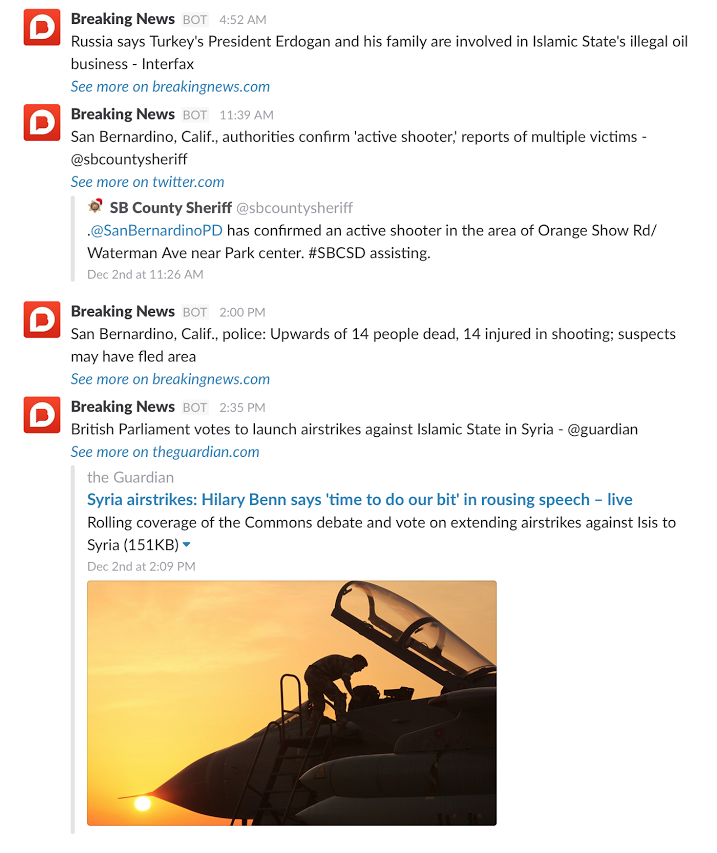How The New York Times and other publishers are using Slack as a content tool

Slack the communications tool has for some publishers become Slack the publishing tool.
Publishers adopted Slack to cut down on email and open up communication, but many are now finding that Slack can also enable forms of publishing. Slack’s real-time nature has made it a viable way for publishers to keep track of breaking-news stories, for example, while other publishers are finding that Slack can be a viable alternative to run-of-the-mill live-blogging software.
“Slack has made ease of integration a priority. It’s trying to serve as a platform, not just a way for people to communicate,” said New York Times interactive news developer Michael Strickland. “It’s something people are relying on and integrating more deeply into their systems. It’s been effective at that so far.”
Breaking News: Letting news organizations give story tips directly from Slack
Slack, as of October, had 1.7 million daily active users, most of whom are glued to the app at least eight hours a day. And where their users go, publishers are soon to follow. In August, Breaking News introduced a custom Slack integration that lets other organizations users pipe global news alerts directly into their Slack channels. Breaking News created the integration after getting multiple requests from news organizations who had created their own alterntaives with RSS feeds, said Breaking News general manager Cory Bergman, who said that “several hundred” organizations have integrated the feature since August.
“Since there are so many people using Slack, this felt like a natural fit for us. It was an easy way for us to test something and see if there was any interest,” Bergman said.
Breaking News plans to take its Slack integration further. Future updates will include the ability to let publishers get topic-based notifications and the ability to tip Breaking News on big stories through a slash command within Slack.
The New York Times: Using Slack to live-blog big events
The New York Times has gone all-in on Slack. Not only has it created hundreds of Slack channels for specific editorial and developer projects but it has also brought Slack directly into its editorial workflow. For the Republican presidential debate in August, The Times created a custom integration that let it live blog the event within Slack. Not only has it used the integration for every presidential debate since then, but it also used it for its live overage of Apple’s event in October.
The Slack live-blogging tool isn’t replacing the Time’s existing WordPress live-blogging software, but it’s become a viable alternative for events that work best with lighter, more conversational coverage. “A lot of it is about the context of Slack. People writing there are used to a more conversational tone with shorter posts, so it’s easier for multiple reporters to talk amongst each other there,” said Strickland.
AJ+: Using Slack as an extension of the CMS
AJ+, Al Jazeera’s digital-first site aimed at millennials, has found a variety of ways to integrate Slack more deeply into its publishing workflow. Late last year, it used Slack to streamline its coverage of Ferguson, Missouri, where reporters used Slack to send their video footage to editors in San Francisco. More recently, its tech team built a bot that notifies editors when videos have been uploaded to the AJ+’content delivery network. The site has also used Slack to create a shared Slack channel with Upworthy, with which it has co-produced stories.
“Slack has in a lot of ways become a second CMS for us,” said Jigar Mehta, engagement lead at AJ+. “Everyone is spending so much time in Slack daily that it make sense for us for that to be the place to put hooks into other services.”
More in Media

Digiday+ Research: Publishers take their focus off events as revenue dips
The percentage of publishers making money from events hit a low as of the first quarter of this year and, as a result, fewer publishers plan on putting a focus on growing that part of their business.

What platforms, brands and agencies hope to get out of the Possible conference in year 2
Year two of Possible is once again being held in Miami Beach, and it will take place from April 15-17 with 3,000 attendees expected to listen to another 200 or so speakers, including Snap’s Colleen DeCourcy, Uber Ads’ Megan Ramm and UM Worldwide’s Matthew Smith.

AI Briefing: Cloud giants’ AI ambitions create new partnerships — and new competitive concerns
Last week, tech companies like Google, Microsoft and Amazon all announced updates more updates for their cloud and AI efforts







